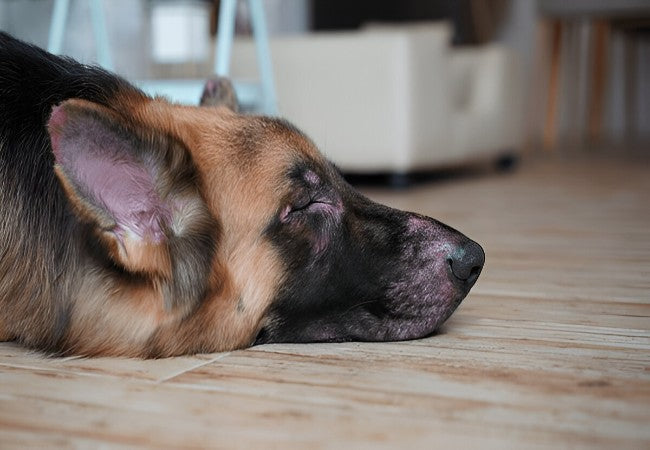Veterinary Guide to Canine Dermatomyositis 2025 🩺🐶

In this article
Veterinary Guide to Canine Dermatomyositis 2025 🩺🐶
By Dr. Duncan Houston BVSc
🧬 What Is Dermatomyositis?
Dermatomyositis is an inherited inflammatory condition affecting the skin, muscles, and blood vessels—classified as an ischemic dermatopathy of immune-mediated origin. Typically diagnosed in puppies and young dogs (onset between 7 weeks to 6 months), most commonly in Collies and Shetland Sheepdogs, with sporadic cases reported in breeds such as Beaucerons, German Shepherds, Chow Chows, Rottweilers, Dachshunds, Corgis, and Fox Terriers.
👀 Clinical Signs
Skin lesions often appear first, affecting:
- Face (around eyes, muzzle, lips), ear tips, tail tip, distal limb skin.
- Signs include erythema, alopecia, crusting, scaling, vesicles/pustules, erosions, and ulcerations; lesions may scar and shift pigmentation.
- Over bony prominences – ischemic changes typical of vasculopathy.
🥩 Muscle & Systemic Signs
- Mild to severe: muscle atrophy (especially masticatory and distal limb muscles), difficulty eating, gait abnormalities.
- Megaesophagus and regurgitation from esophageal muscle involvement.
- Severity ranges from mild and self-resolving to debilitating.
🎯 Diagnosis
- Signalment & history: Young Collie-type breed with crusted face/tail/ears; seasonality or flare triggers (heat, sun, trauma).
- Physical exam: Document skin lesion pattern, muscle condition, and possible megaesophagus signs.
- Lab tests: CBC, biochemistry, CK levels; rule out infection/allergy.
- Histopathology: Skin biopsy (vascular and muscle ischemia); muscle biopsy/EMG if myositis suspected.
- Rule out differentials: Demodicosis, pyoderma, dermatophytosis, discoid lupus, vasculitis disorders.
🛠️ Treatment & Management
1. Environmental & Supportive Care
- Limit UV exposure—indoor time, shade, protective clothing.
- Minimize trauma—avoid rough play or harness chafing.
- Supplement skin and blood flow support: Essential fatty acids, vitamin E (200–600 IU BID), pentoxifylline 15–25 mg/kg BID.
2. Immunomodulation
- Glucocorticoids: prednisone 1–2 mg/kg/day initially; short taper during flares.
- Adjuncts: niacinamide + tetracycline/doxycycline, cyclosporine, tacrolimus topically, azathioprine—especially in steroid-refractory cases.
3. Myositis / Megaesophagus Support
- Mild exercise to preserve muscle function, tailored to ability.
- Elevated feeding bowls, slow feeding protocols or a feeding tube in megasophagus.
📈 Prognosis & Monitoring
- Prognosis varies—mild cases may resolve, severe cases require long-term management and often result in scarring. Dogs should not breed.
- Monitor monthly → less frequently post-stabilization: skin exam, muscle condition, CK levels.
- Anticipate flare management plan; have medications ready, especially during sun/injury exposure seasons.
🏠 Home & Lifestyle Advice
- Apply sunscreen/clothing before sun exposure.
- Provide soft bedding and avoid abrasive environments.
- Give supplements and meds reliably; log signs weekly.
- Adapt feeding routine to prevent regurgitation—maintain weight.
📱 Ask A Vet Telehealth Support
- 📸 Upload lesion photos to monitor healing and catch flare-ups early.
- 🔔 Medication reminders—prednisone taper, pentoxifylline, supplements.
- 🧾 Lab test alerts (CK, CBC) and teletriage for flare response.
- 📅 Scheduled remote check-ins for skin and muscle condition.
🎓 Case Spotlight: “Skye” the Sheltie
Skye, a 3-month-old Sheltie, developed facial crusting and ear tip alopecia in spring. Biopsy confirmed dermatomyositis. Treatment included sun avoidance, vitamin E, pentoxifylline, and topical tacrolimus. Lesions resolved in 6 weeks; mild recurrent flares each summer are managed preemptively. Skye’s owners use the Ask A Vet app for photo updates and medication reminders—keeping her coat healthy and crisis-free. 🌞🐕🦺
🔚 Key Takeaways
- Dermatomyositis is an inherited immune vasculopathy in Collies/Shelties causing skin lesions and sometimes muscle issues.
- Treat with UV avoidance, immunomodulation (pentoxifylline, steroids), supplements, and flare management plans.
- Biopsy confirms diagnosis; monitoring and owner education are essential.
- Ask A Vet telehealth complements care with reminders, alerts, teletriage, and topical/muscle support. 🩺📱
Dr Duncan Houston BVSc, founder of Ask A Vet. Download the Ask A Vet app today to support your dog's dermatomyositis journey—with expert remote guidance, flare prevention, medication tracking, and telemonitoring 🐶📲






